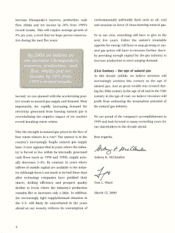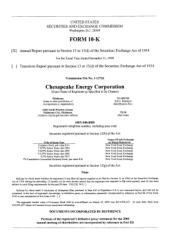Chesapeake Energy 1999 Annual Report Download - page 16
Download and view the complete annual report
Please find page 16 of the 1999 Chesapeake Energy annual report below. You can navigate through the pages in the report by either clicking on the pages listed below, or by using the keyword search tool below to find specific information within the annual report.
As a result of our high level of indebtedness and poor conditions in the energy industry, Standard & Poor's
Corporation and Moody's Investors Service reduced the credit ratings on our senior notes to "B" and "B3",
respectively, in late 1998. These ratings were removed from credit review in 1999. Our credit ratings could
negatively impact our ability to access capital markets.
The Volatility of Oil and Gas Prices Creates Uncertainties.
Our revenues, operating results and future rate of growthare highly dependent on the prices we receive for our oil
and gas. Historically, the markets for oil and gas have been volatile and may continue to be volatile in the future.
Various factors which are beyond our control will affect prices of oil andgas. These factors include:
worldwide and domestic supplies of oil and gas,
weather conditions,
the ability of the members of the Organization of Petroleum Exporting Countries to agree to and maintain
oil price and production controls,
political instability or armed conflict in oil-producing regions,
the price and level of foreign imports,
the level of consumer demand,
the price and availability of alternative fuels,
the availability of pipeline capacity, and
domestic and foreign governmental regulations and taxes.
We are unable to predict the long-term effects of these and other conditions on the prices of oil and gas. Lower oil
and gas prices may reduce the amount of oil and gas we produce, which may adversely affect our revenues and
operating income. Because in 2000 we plan to match as nearly as possible our capital expenditures for drilling and
acquisition activities to cash flow from operations, significant reductions in oil and gas prices may require us to
reduce our capital expenditures. Reducing drilling will make it more difficult for us to replace the reserves we
produce.
We Must Replace Reserves to Sustain Production.
As is customary in the oil and gas exploration and production industry, our future success depends largely upon
our ability to find, develop or acquire additional oil and gas reserves that are economically recoverable. Unless we
replace the reserves we produce through successful development, exploration or acquisition, our proved reserves will
decline over time. In addition, approximately 28% by volume, or 20% by value, of our total estimated proved
reserves at December 31, 1999 were undeveloped. By their nature, undeveloped reserves are less certain. Recovery
of such reserves will require significant capital expenditures and successful drilling operations. We cannot assure
you that we can successfully find and produce reserves economically in the future.
Sign Ulcant Capital Expenditures Will be Required to Exploit Reserves.
We have made and intend to make substantial capital expenditures in connection with the exploration,
development and production of our oil and gas properties. Historically, we have funded our capital expenditures
through a combination of internally generated funds, equity issuances and long-term debt financing arrangements and
sale of non-core assets. From time to time, we have used short-term bank debt, generally as a working capital
facility. Future cash flows are subject to a number of variables, such as the level of production from existing wells,
prices of oil and gas, and our success in developing and producing new reserves and in selling non-core assets. If
revenue were to decrease as a result of lower oil and gas prices or decreased production, and our access to capital
were limited, we would have a reduced ability to replace our reserves. If our cash flow from operations is not
sufficient to fund our capital expenditure budget, there can be no assurance that additional debt or equity financing
will be available to meet these requirements.
-6-
























